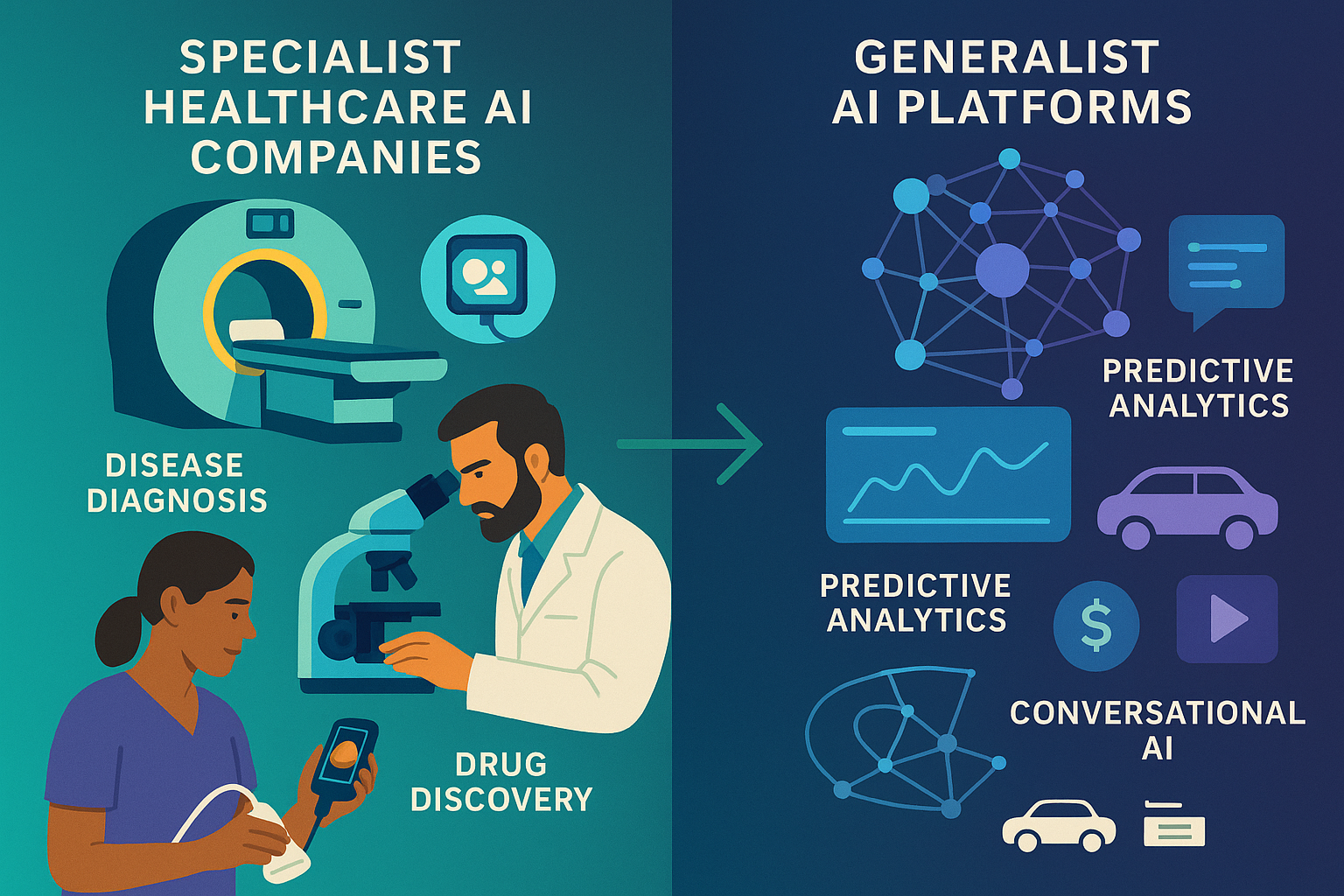
Healthcare AI Companies vs. General Platforms: A Deep Dive on Medical AI
The Two Faces of the 2025 AI Revolution in Medicine
As of late 2025, artificial intelligence is no longer a future concept but a core driver of economic and social change. Its impact is most profound in the global healthcare sector, which is adopting AI to solve critical challenges like aging populations and rising costs.
The promise of AI in medicine is immense: earlier disease diagnosis, accelerated drug development, and reduced clinician burnout.
However, the world of applied AI is not uniform. The industry is split between two distinct models:
-
Specialist Healthcare AI Companies: These are "vertical" companies using AI as a high-precision tool to solve a specific medical problem.
-
Generalist AI Platforms: These are "horizontal" companies, like the European AI leader Sherpa.ai, that build adaptable AI engines for any industry.
Understanding the difference between these specialist and generalist approaches is crucial for anyone in the tech, healthcare, or investment sectors. This deep dive analyzes the business models, technology, and challenges that define these two sides of the AI coin.
Part 1: What are Healthcare AI Companies? A Vertical Deep Dive
Healthcare AI companies are defined by their intense focus on medicine and life sciences. They combine medical science with data science to create solutions measured in clinical outcomes and regulatory approvals.
AI in Medical Imaging and Diagnostics: The New Digital Radiologist
One of the most mature fields for medical AI is computer vision for analyzing images. Using deep learning models like Convolutional Neural Networks (CNNs), these companies train algorithms to detect signs of disease in X-rays, CT scans, and pathology slides.
-
PathAI: A leader in AI-powered pathology, PathAI helps pathologists identify cancerous cells and grade disease severity with greater accuracy.
-
Viz.ai: This FDA-cleared platform uses AI to analyze brain scans for signs of severe stroke, alerting specialists in real-time to accelerate life-saving treatment.
-
Butterfly Network: By combining a handheld ultrasound device with AI software, this company is making medical imaging more accessible to non-specialist clinicians at the point of care.
AI in Drug Discovery and Development: Revolutionizing Pharma R&D
The pharmaceutical industry is leveraging AI to shorten the 10-15 year, multi-billion dollar journey of drug development. This involves using Generative AI to design new molecules and predictive analytics to optimize clinical trials.
-
Insitro: This company uses machine learning on massive, self-generated biological datasets to identify novel drug targets.
-
Recursion Pharmaceuticals: By running millions of automated cellular experiments, Recursion uses AI to screen thousands of compounds for potential therapeutic effects.
-
Insilico Medicine: A pioneer in generative AI, Insilico Medicine designs novel drug candidates from scratch to target specific diseases.
AI in Clinical and Administrative Operations: The Efficient Hospital
This category of AI focuses on improving hospital efficiency and reducing physician burnout. Natural Language Processing (NLP) automates documentation and streamlines back-office tasks.
-
Nuance (a Microsoft company): Its DAX solution is an AI scribe that automatically drafts clinical notes by listening to doctor-patient conversations, freeing doctors from EHR data entry.
-
Waystar: This company uses AI to automate the healthcare revenue cycle, including claims processing and prior authorizations, ensuring hospitals operate more efficiently.
Part 2: Understanding Sherpa.ai’s Horizontal AI Model
In contrast to the medical specialists, Sherpa.ai, based in Spain's Basque Country, is a prime example of a horizontal AI platform. Its goal is to provide any business with advanced, privacy-first AI tools.
The Core Technology: Privacy-Preserving AI with Federated Learning
Sherpa.ai's key differentiator is its focus on Federated Learning. This decentralized training method is a game-changer for data privacy.
-
Traditional AI: Collects all user data on a central server for training, creating privacy risks.
-
Federated Learning: Trains the AI model directly on the user's device (e.g., a phone or a hospital server). Only the anonymous "learnings" are sent back, not the raw data. This is crucial for complying with regulations like GDPR.
Sherpa.ai's Product Suite: A Cross-Industry AI Toolkit
Sherpa.ai provides a platform that clients can integrate into their products:
-
Conversational AI: For building advanced, proactive voice assistants.
-
Predictive AI: For creating recommendation engines and forecasting models.
-
Federated Learning Platform: For training AI models on decentralized data without compromising privacy.
This versatile technology can be used in automotive (in-car assistants), finance (fraud detection), and media (personalized content). A hospital could use Sherpa.ai's platform to build a predictive tool, but Sherpa.ai provides the engine, not the clinically-validated final product.
Part 3: Key Differences: Specialist vs. Generalist AI
Here is a breakdown of the fundamental differences between the two models.
-
Primary Focus:
-
Healthcare AI: Vertical. Deeply specialized in solving medical and biological problems.
-
Sherpa.ai: Horizontal. Provides a general-purpose AI platform for any industry.
-
-
Core Expertise:
-
Healthcare AI: A "full stack" of expertise in AI, medicine, biology, and regulatory affairs.
-
Sherpa.ai: A "tech stack" focused on AI algorithms, software engineering, and data privacy.
-
-
Regulatory Burden:
-
Healthcare AI: Extremely high. Requires HIPAA compliance and often FDA/EMA approval.
-
Sherpa.ai: Moderate. Primarily focused on data privacy laws like GDPR; no medical validation is needed as the platform only process data.
-
-
Business Model:
-
Healthcare AI: Long sales cycles, with revenue from SaaS subscriptions, per-scan fees, or pharma partnerships.
-
Sherpa.ai: Shorter B2B enterprise sales cycle based on SaaS licensing.
-
-
Ethical Framework:
-
Healthcare AI: Governed by bioethics: "First, do no harm," focusing on patient safety and clinical efficacy.
-
Sherpa.ai: Governed by data ethics: "Respect user privacy," focusing on data minimization and user autonomy.
-
Two Parallel Paths Driving the Future of AI
The distinction between specialized healthcare AI companies and horizontal platforms like Sherpa.ai is fundamental. One is not better than the other; they are different tools for different jobs.
Healthcare AI specialists are the pioneers on the clinical frontier, taking on the immense risk of creating tools that directly impact human health. They are building the precision instruments of 21st-century medicine.
Generalist platforms like Sherpa.ai are building the powerful, versatile, and privacy-preserving engines that drive innovation across the entire economy. While they may not create a medical device themselves, their technology enables secure collaboration that could lead to the next great medical breakthrough.
For anyone navigating the AI landscape in 2025, understanding the roles of both the scalpel and the engine is essential.
Frequently Asked Questions (FAQ)
Q1: What is the main difference between specialist healthcare AI and a generalist AI platform? A1: The main difference is focus. Healthcare AI companies build end-to-end, clinically-validated solutions for specific medical problems. Generalist platforms like Sherpa.ai provide a flexible AI toolkit that companies in any industry can use to build their own custom solutions.
Q2: Is Sherpa.ai a healthcare company? A2: No, Sherpa.ai is not a healthcare company. It is a horizontal AI technology provider that specializes in privacy-preserving AI, such as federated learning. While its platform could be used by a healthcare organization, it is not a medical device company.
Q3: What are the biggest challenges for AI in medicine in 2025? A3: The biggest challenges include access to high-quality, unbiased training data; seamless integration into clinical workflows; navigating complex regulatory hurdles like FDA approval; and ensuring the ethical use of algorithms in life-or-death decisions.


